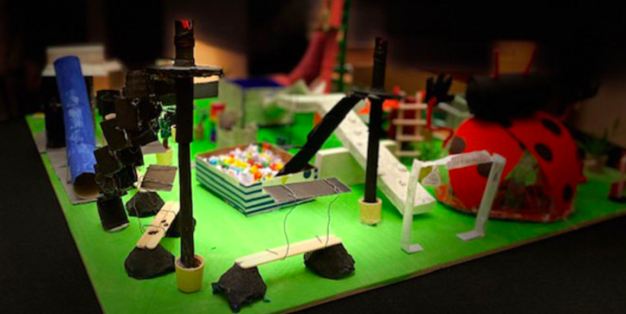In Gothenburg and other major cities, large densification projects are planned in the coming years. But how can we adapt the city for the children when the areas become denser, and the green areas become fewer? Students at Chalmers think daily about such questions in various projects, often in close collaboration with the city.
Several student projects have been conducted with a focus on the child perspective, for example in the course Design and planning for social inclusion where master students from Chalmers have designed and shaped a number of child-friendly places in the city, such as a parkour park, a space-themed playground and an outdoor classroom, that was named ‘The story of Gärdsås bog’, write Vedrana Sivac and Johanna Fasth.
‘It’s important that architects train to listen, engage and involve the children’
“It is very important to raise the children’s perspective, otherwise it is a group that is easily forgotten, because they do not have a voice in society as adults do. Therefore, it is important that architects train to listen, engage and involve the children in each project, regardless of whether the project itself focuses on the children or not,” says Emilio Da Cruz Brandao, who teaches architecture at Chalmers and manages degree projects in the master’s program Architecture and planning beyond sustainability.
The students in the Reality studio course work globally with the children’s perspective and have, among other things, been involved in projects such as building playgrounds and schools in Kenya.
“When the students return, they will present their process to the children here in Gothenburg, to show how important the children’s perspective is all over the world. It will be a very important learning process for everyone,” adds Da Cruz Brandao.
One student who has worked to raise the perspective of children and was involved in the project to build the outdoor classroom is Victoria McCrea. In her degree project, she designed a preschool and a language school together in the same building in Kortedala, Gothenburg. This project was based on her experience of being both an SFI (Swedish for immigrants) student and a preschool substitute in Gothenburg and was created in close collaboration with SFI teachers.
“I think it is important as an architect to gather opinions from those who will use the places we create,” she says.
Today, Victoria McCrea works with drawing schools in an architect’s office in Lund, Sweden.
“It is still early in my career, but I hope I will get to use all my experiences in future projects. Life after school is a completely different sea to navigate. You rarely get to work with customers who are willing to pay to get the woodpecker, frog dance and children’s opinions into a project, but that does not mean that it is impossible to create space for them!”
The Technology Competition continues this theme
This year’s Technology Competition, which is aimed at fifth and sixth graders, is also linked to the theme of the children’s perspective in the cityscape. The students have been given the task of building their visions of what a playground will look like in 100 years, by building a creative model that will encourage them to play outdoors together. They have had to work as real engineers, from idea to finished prototypes. Then they have filmed their projects where they talk about what they want the playgrounds of the future to look like.
Nearly 130 contributions have been received from all over Sweden. Of these, six grants have excelled the most and they are allowed to share SEK 25,000 in scholarships.
Dorotea Blank at Chalmers works to inspire and engage children and young people and has been a driving force in the Technology Competition.
“Engaging in future generations’ development of knowledge is one of the best investments that Chalmers can make for the future. I am convinced that the students’ desire for technology and creative problem solving has been aroused through this year’s challenge. A big compliment to all teachers who drive, inspire, and push the students. It is noticeable that the children have had great fun,” she says.
This is confirmed by students from Bergsgårdsskolan in Angered, Gothenburg, who say that the most fun thing about participating in the Technology Competition was building and thinking about what the future will look like.
Teacher Michaela Oskarsson agrees: “We see that it is inspiring and developing for the children to be involved and that they have got a good idea of the technology subject and what an engineer can work with.”





